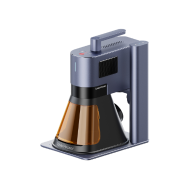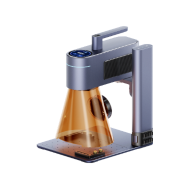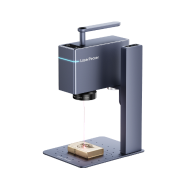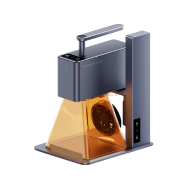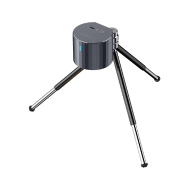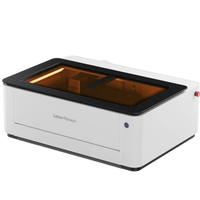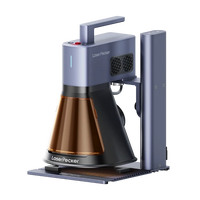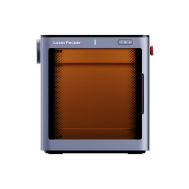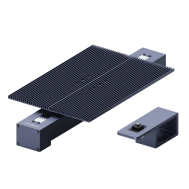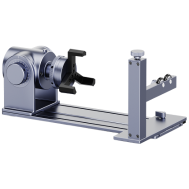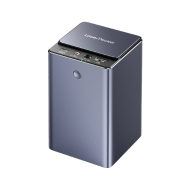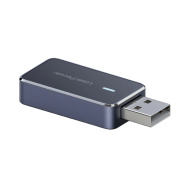In this article:
How High Can The Precision of Laser Engraving Machines Be?
The precision of laser engraving machines theoretically reaches very high levels, typically within the range of 0.01mm to 0.001mm. The specific precision depends on various factors such as the machine model, manufacturing quality, and laser technology utilized. It's worth noting that LaserPecker 4 laser engraving machine has achieved a calculation precision of 0.00199mm, leading the way among similar laser engraving machine products, offering users an exceptional laser engraving experience.
However, it's important to note that this figure represents the ideal precision value. In real-world applications, the actual working precision may be affected by multiple factors, including material characteristics, working environment, machine wear and tear, calibration, and maintenance. In actual applications LaserPecker 4 laser engraving machine has achieved a measurable precision of 0.003mm.

What Are Factors Affecting Laser Engraving Machine Precision?
Several factors impact the precision of laser engraving machines, including both internal and external factors. This text focuses solely on the internal factors that affect the machine itself, including but not limited to the "Galvanometer System, Optical System, and Motion Control System". The concepts of "Galvanometer, Beam Spot, Movement Accuracy, Positioning Accuracy, and Repeat Positioning Accuracy" in relation to laser engraving precision will also be extensively discussed.
1. Galvanometer System
The galvanometer system is a crucial component within laser engraving machines, responsible for controlling the laser beam's direction and position, ensuring precise engraving and cutting. Typically consisting of two main galvanometers, it controls the movement in the horizontal (X-axis) and vertical (Y-axis) directions. Some systems may also include a third galvanometer for adjusting focus (Z-axis).
The working principle of the galvanometer is based on electromagnetic drive or motor control. They can be quickly turned and precisely positioned to adjust the position and direction of the laser beam. This fast, precise response is a key factor in ensuring that the laser beam moves along its intended trajectory.

The galvanometer functions:
- High-speed motion: Rapid response and precise positioning of the galvanometer system cater to the demand for high-speed laser beam movement, ensuring efficient engraving processes.
- Accurate positioning: The galvanometer system is designed for precise positioning of the laser beam to ensure movement along the designated path. High-precision positioning is crucial for achieving high-quality engraving.
- Stability and reliability: The stability of the galvanometer system is vital for prolonged operations and consistent work. A stable system ensures uniformity and accuracy in engraving.
- Control and adjustment: Managed by controllers or drivers, the galvanometer system receives signals from the control system to adjust the galvanometer's position and angle. Optimized control algorithms ensure precise movement of the galvanometer.
- Beam correction: In some systems, galvanometers are also utilized for correcting the laser beam's shape and direction, ensuring optimal focus on the focal point.
2. Optical System
The optical system of a laser engraving machine includes components such as the laser, lens assembly, and reflectors, collectively ensuring the quality and stability of the laser beam. This system focuses the laser beam onto the workpiece surface, forming the required size and shape of the beam spot. Precise focusing is crucial for achieving high-precision engraving.
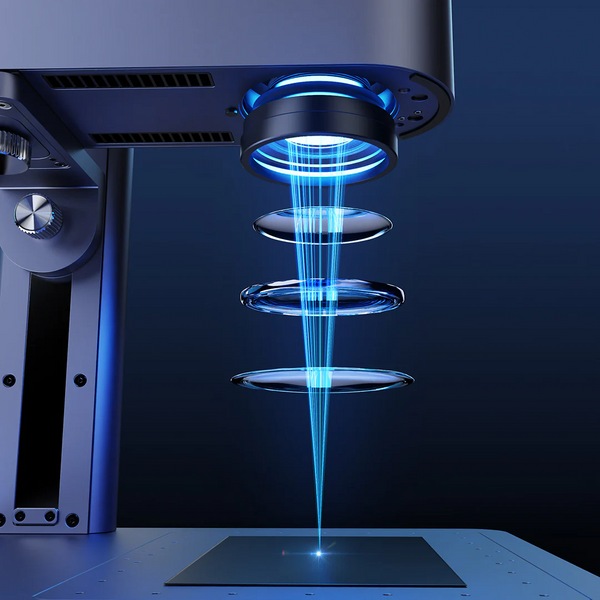
Key elements of the optical system:
- Laser: Generating a high-energy and stable laser beam is crucial for the optical system. The quality and performance of the laser determine the machine's operational efficiency and engraving quality.
- Lens assembly: Used to adjust the laser beam's focal length and focus, controlling the size and shape of the beam spot. High-quality lens assemblies are crucial for generating precise and clear beam spots.
- Reflectors: Guiding the laser beam's path to ensure it follows the correct trajectory, passes through the galvanometer system, and ultimately focuses on the work surface. Stable and highly reflective mirrors contribute to the laser beam's quality and stability.
Importance of the beam spot in laser engraving:
The beam spot refers to the area where the laser beam is focused on the workpiece surface. The size and shape of the beam spot directly impact the engraving's precision and clarity. A smaller and more uniform beam spot generally signifies higher resolution and finer engraving effects. The optical system and focusing ability of the laser engraving machine directly influence the size and quality of the beam spot.
- Focusing ability: Focusing lenses or mirrors concentrate the laser beam onto the workpiece surface, forming the desired size and shape of the beam spot. A superior focusing system can produce small and uniform beam spots, facilitating high-precision engraving.
- Beam spot size: Smaller beam spots result in higher detail and precision in engraving. Generally, smaller beam spots achieve higher resolution engraving.
- Beam spot shape: Beam spots should ideally be circular or near-circular; irregularly shaped beam spots may lead to uneven engraving results.
3. Motion Control System
The motion control system of a laser engraving machine is responsible for controlling the machine's movements and operations, comprising both hardware and software components. This system sends commands and controls the movements of galvanometers, work platforms, and other essential components.
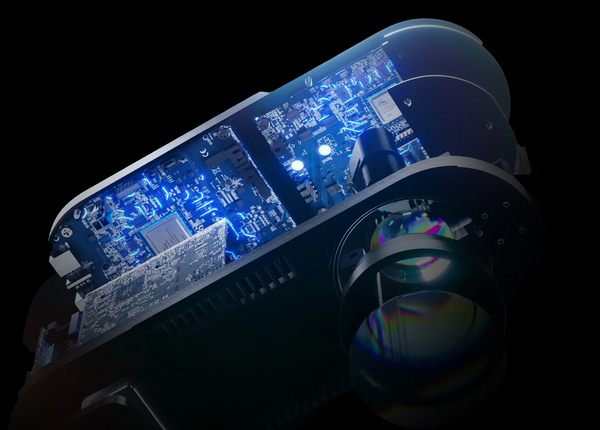
Hardware components of the motion control system:
- Mechanical structure: The machine's mechanical structure dictates the movement and stability of each axis (usually X, Y, Z axes). A stable and precise mechanical structure is crucial for ensuring the accuracy of motion axes.
- Drives and motors: Drives and motors drive the motion axes. High-performance drives and motors provide stable and precise movements, ensuring engraving precision and efficiency.
- Position sensors and feedback systems: Position sensors monitor the positions of motion axes, and the feedback system corrects potential position errors based on sensor data, ensuring the laser engraving machine accurately returns to previous working positions.
Software components of the motion control system:
- Motion control algorithms: These algorithms handle path planning, optimization, and real-time motion control. They ensure the laser beam moves along the planned trajectory and speed on the work surface to maximize engraving efficiency and precision.
- Controller: The controller is the core of the motion control system, receiving user commands, executing algorithms, and controlling the hardware components (drives, motors, etc.)' movements.
Key Concepts of Motion Control System:
- # Movement Accuracy
Movement accuracy refers to the accuracy of the laser engraving machine when controlling the movement of each axis. High movement accuracy means the machine accurately moves to predefined positions while maintaining precise speed and direction. Generally, the concept of movement accuracy includes positioning accuracy and repeat positioning accuracy.
- # Positioning Accuracy
Positioning accuracy refers to the machine's ability to stop accurately and reach the desired positions. In laser engraving, positioning accuracy involves the laser beam's location to ensure it engraves in the correct spot.
Positioning accuracy simplified explanation: The error between the actual position reached when the machine stops and the required position, for instance, if a motion axis should move 100mm but actually moves 100.01mm, the extra 0.01mm is the positioning accuracy.
- # Repeat Positioning Accuracy
Repeat positioning accuracy refers to the machine's ability to return to the same position in multiple work cycles. Even after stopping and restarting in different work cycles, the machine can accurately return to the previously engraved position, ensuring consistent engraving effects.
Repeat positioning simplified explanation: The error produced between two or more movements to the same position, for instance, if a motion axis should move 100mm, and the first time it moved 100.01mm, and in the repeated action, it moved 99.99mm, the difference of 0.02mm between the two movements is the repeat positioning accuracy.
Conclusion
These factors play vital roles in the design and manufacturing of laser engraving machines.
LaserPecker 4 laser engraving machine strives to optimize galvanometer systems, enhance optical systems, improve motion control systems, etc., to provide higher movement accuracy, positioning accuracy and repeat positioning accuracy, ensuring superior engraving results!
Visit Wikipedia for more information about Accuracy and Precision!
